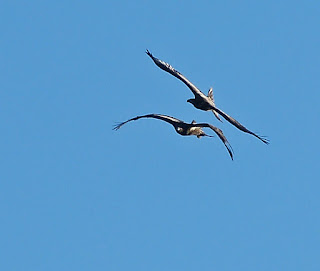Today we "discovered" a wonderful new place to bird in Central Florida - the
Orlando Wetlands Park. This is actually a water treatment mitigation area, operated by the City of Orlando to complete treatment of waste water. We always have good birding at water treatment facilities, and this was no exception. The day started cold and dreary - even with a sweatshirt on, I wished I'd brought my gloves. We rushed to the park to take a guided tram ride led by two volunteers, and accompanied by two other birders carrying big scopes. This was our big opportunity to see more unusual birds which we probably wouldn't have found on our own, as they were clear at the back of the property.
"If you build it, they will come..." the birds, I mean. In 1986, this whole area was a cattle farm, which was purchased by the city. Reclaimed water from the sewage system takes 40 days to run through this man-made marsh system, which removes the remaining nitrates and contaminants. The
reclaimed water flows first into the cells with the deep marsh habitat, which
consists primarily of monocultures with either cattails or giant bulrush.
Afterwards, the flow is routed through the mixed marsh and wet prairie cells
containing thick growths of pickeralweed, duck potato and other aquatic shrubs.
These areas are favored by the wading birds and migratory waterfowl. The final
habitat in the wetland system is the hardwood swamp. Cypress, popash, tupelo and
water hickories dominate within these cells. However, due to the constant high
water levels, the trees have stunted growth and this habitat typically mirrors
the deep marsh areas. A 100 acre lake is part of the central and southern flow
paths through the wetland system. At least 17 million gallons of clean water is released into the St. John's River
every day!
Many of the places we visited this week lacked the larger wading birds we so enjoy when we come to Florida, but the Orlando Wetlands certainly made up the difference today! At Green Cay in Palm Beach County, we saw one Limpkin and felt lucky. Today, we must have seen ten or more.
Our next target bird was the Vermilion Flycatcher. Our tram driver-volunteer has an unblemished record of finding this bright red bird wearing a Zorro mask each trip he makes to the back areas. As we left this afternoon, he told us they had found more, including females and young, so these small Flycatchers have several breeding families.
In Florida, when they say "hawk," they really mean Red-shouldered Hawk, since Red Tails are few and far between. Palm trees from the old pasture land have died, leaving just clusters of trunks without fronds throughout the lakes. Such natural perches are the favorites of Red-shouldered Hawks. Two of them were in love, and couldn't wait for a secluded place for a little romance!
White-billed American Coots and red-billed Moorhens shared the shallow water without difficulty, clucking all day long. However, we searched for the elusive Purple Gallinule, and found a dozen or more - another first for Dick and me! Look at his long yellow feet as he walks across the tops of the lily pads! The candy corn colors on the beak always stand out, even if the light isn't good for seeing purple feathers. We heard quite a few King Rails, but it would have been asking too much for them to come into view from the bull rushes.
Anhingas are beautiful black and white birds. During breeding season their nares turn bright blue. What a handsome lad this one is! They dive for fish, and then stand with their wings spread to dry since they have no oil on their feathers as other birds do.
Cormorants have a slightly hooked beak, and catch fish between the top and bottom mandibles, toss it up and swallow it head first. The Anhinga, on the other had, has a perfectly straight beak which they use to
spear their fish! This is the first time I've ever seen this behavior. Of course, then the problem is getting it off the beak and into the throat. This fish is obviously much bigger than the birds throat and we watched to see how he would handle the situation. We thought the fish must surely be dead, having been out of the water so long, but in a flash it ended up back in the water, and the Anhinga planned another fishing trip.
Normally, you envision an Ibis to be white, with startlingly red beak and legs...
... but the dark Glossy Ibis is also beautiful...
The endangered Wood Stork shared a rookery with Ibis and Egrets of all sorts.
There is actually a separate subspecies of Sandhill Cranes in Florida, where it is protected, and if killed, carries a very high monetary penalty. This subspecies is under protection of state and federal law at this time. Since the loss of habitat is a somewhat controllable cause of a declining population, habitat preservation is a valuable management measure. The current outlook for the Florida sandhill crane, if it can be maintained on the protected habitats, is good.
It's not hard to tell these large birds apart when in flight. The Great Blue Heron, Great Egret and Snowy Egret fly with necks tucked in an "S" shape. Wood Storks, Ibis, and Sandhill Cranes fly with necks out-stretched.
Well, I could probably go on, after our thrilling day, but it's getting late and Dick wants to use the computer, so I'd better close for now. Only one more day of birding, then it's time to head home in the Big Bird in the Sky!







































